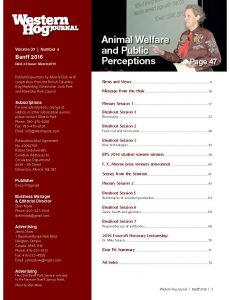Western Hog Journal Banff 2016
Articles in the Banff 2016 Western Hog Journal include:
 Clear Path for Future of Canadian Hog Industry, Pork export Markets and Trade Agreements
Clear Path for Future of Canadian Hog Industry, Pork export Markets and Trade Agreements
-
- Three areas to focus on for the future include animal welfare, health and nutrition as well as environmental sustainability.
- Current trade agreements include the World Trade Organization, the Canada-EU agreement and the Trans Pacific Partnership.
Biosecurity: Canada’s Response to PED and What is Next for Emerging Disease Strategy, Biosecurity and Disease Risk Management in Transportation
-
- Most of Canada’s PED cases have been eliminated through Foreign Animal Disease preparedness plans, prevention through surveillance and elimination.
- Drivers must not be around pigs or have pets in the truck and pass the Trucker Quality Assurance test. Trailers must maximize biosecurity and be easy to wash.
Feed Cost and Net Income: Optimizing Feed and Farm Management to Market Conditions, Alternative Feedstuffs and Feeding Programs for Nursery Pigs
-
- Efficiency in managing cash flow, extending or renegotiating loan terms and liquidation of inventory to pay down debt should be the main focus when the market is bad.
- Optimizing feed usage and efficiency is important due to high feed costs. The use of alternative feedstuffs may help with costs.
New Technologies: JH Automatic Straw/Floor Feed Dispensing System and Slurry Handling (Acidification) System, Infrared Thermography in the Swine Barn
-
- The JH Automatic Distribution System involves a robot, central filling station and rail system and automatically distributes several times a day. Slurry handling decreases the pH to stop ammonia from evaporating, increasing safety and ease of handling.
- Infrared Thermography can help in early detection of diseases by monitoring the temperature of the animals.
Animal Welfare and Public Perceptions
-
- New approaches are needed to reach consumers on improvements in livestock welfare. Using social media could help reach the younger consumers.
- Benchmarks of Excellent Production: Gilt Development – Setting up the Breeding Herd, Achieving High Productivity in Group Housed Sows, Key Indicators of Breeding Herd Productivity.
Proper gilt development ensures the gilt remains in the herd and meets their full potential. Factors to consider include health, selection, housing, puberty induction and diet.
-
- Problems with group housing such as inaccurate feeding, social stress, heat detection, training difficulties and sow management are discussed. Production is similar between the two systems.
- 11 key production numbers that are critical to monitoring and improving production are listed and discussed to have more healthy born piglets.
Swine Health and Genomics: Genomics and Swine Health Part 1 and 2, Impacts of Moving “Clean” Gilts into “Health Challenged” Commercial Sow Farms, Genetic Improvement of Sow and Gilt Reproductive Performance via PRRS Immunity, Genetics of Host Response to PRRS in Growing Pigs, PRRSV and the Pregnant Female
-
- The genome Canada project should lead to tools that can help with swine health. New tools will be provided to select pigs less susceptible to PRRS and PCVAD such as through testing blood.
- New strategies to reduce disease through genomic technologies by optimizing selection for resilient pigs are looked at. This will help select, feed and use microbial management tools for the optimal immune response of pigs.
- Gilts were studied after being introduced to commercial farms with a relevant disease. Genetic variation with PRRS S/P ratios can be partially explained through chromosome 7 regions.
- The S/P ratio may be used as an indicator trait to select for improved reproductive performance during PRRS infection. The response is heritable and genomics may improve performance.
- Genetic basis of different responses to PRRS were investigated. Ability to select pigs that are less susceptible should be possible and more effective vaccines and therapeutics may be developed.
- PRRS causes reproductive failure in pregnant females, often in late gestation. Transplacental PRRS infection was studied along with phenotypic and genotypic biomarkers of resilience.
Responsible Use of Antibiotics: Antimicrobial Use 2016 and Beyond, Controlled Use of Antibiotics, Responsible Use of Antibiotics from a Feed and Management Perspective
-
- Antibiotics should only be used when necessary with the correct drug, route, duration and dose. This will help decrease antimicrobial resistance.
- Areas to improve on in the controlled use of antibiotics are listed and should be followed in order to reduce antibiotic resistance.
- Strategies to reduce antibiotic use should be used. Tips to help producers are listed.

